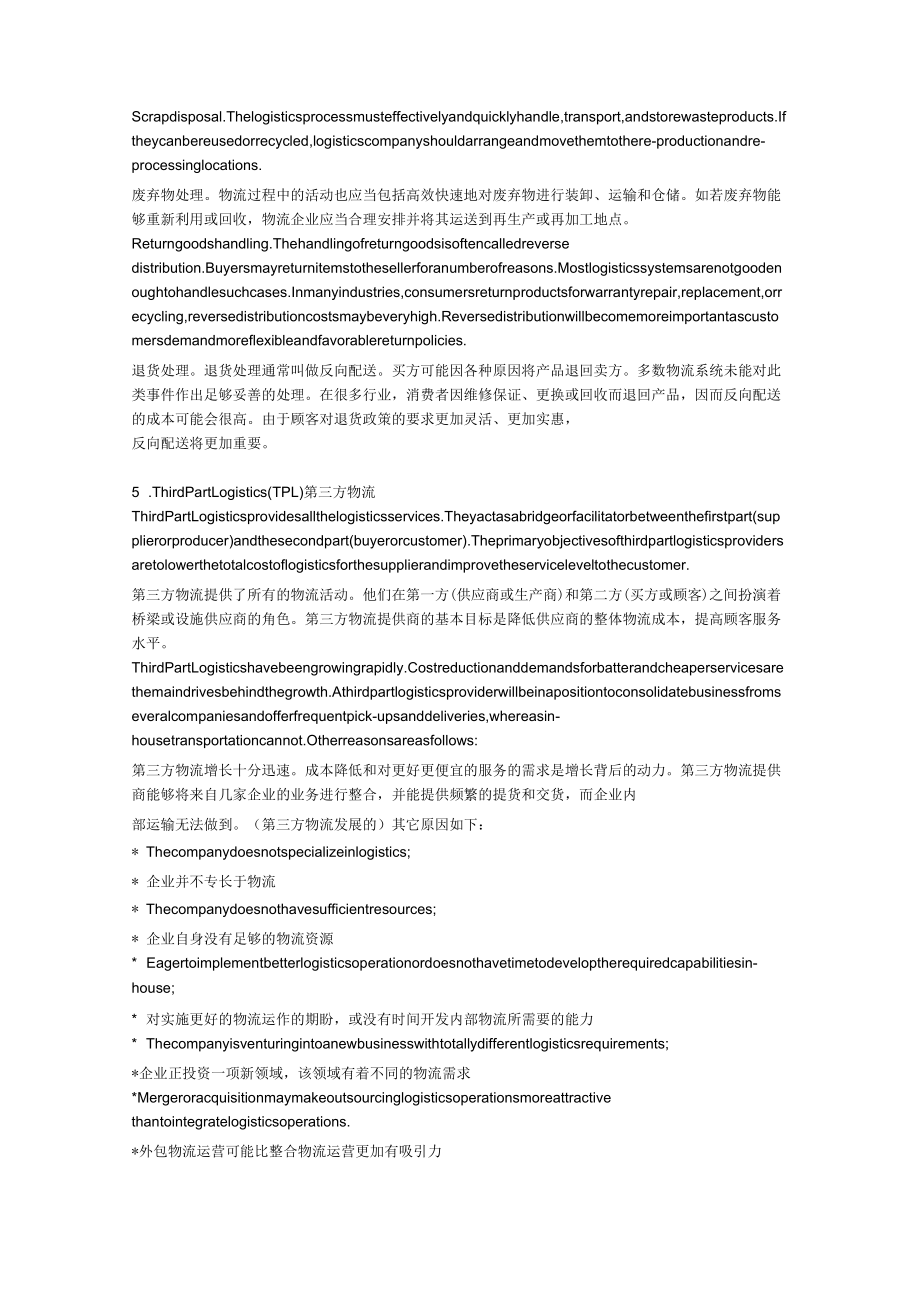




版权说明:本文档由用户提供并上传,收益归属内容提供方,若内容存在侵权,请进行举报或认领
文档简介
1、1. TheDefinitionofLogistics物流的定义Aftercompletingacommercialtransaction,logisticswillexecutethetransferofgoodsfromthesupplier(seller)tothecustomer(buyer)inthemostcost-effectivemanner.Thisisthedefinitionoflogistics.Duringthetransferprocess,hardwaresuchaslogisticsfacilitiesandequipment(logisticscarriers
2、)areneeded,aswellasinformationcontrolandstandardization.Inaddition,supportsfromthegovernmentandlogisticsassociationshouldbeinplace.在完成商业交易之后,物流将以最低成本和最高效益的方式执行将商品从供应商(卖方)流转到顾客(买方)的过程。这就是物流的定义。在物流过程中,既需要诸如物流设施和设备(物流运输工具等)的硬件,也需要对物流实施信息化管理进行物流标准化。此外,政府和物流组织的支持也不可或缺。Threemajorfunctionsoflogistics物流的三大主
3、要功能(1) Creatingtimevalue:samegoodscanbevalueddifferentatdifferenttimes.Goodsoftenstopduringthetransferprocess,whichisprofessionallycalledthestorageoflogistics.Itcreatesthetimevalueforgoods.(1)创造时间价值:同种商品因所处时间的不同而有着不同的价值。在商品流车t过程中,往往会处于某种停滞的状态,物流的专业术语就称之为储存。储存创造了商品的时间价值。(2) Creatinglocationvalue:same
4、goodscanbevalueddifferentlyatdifferentlocations.Thevalueaddedduringthetransferprocessisthelocationvalueoflogistics.(2)创造场所价值:同种商品因所处位置的不同而有着不同的价值。这种因商品流转过程中而产生的附加增值称之为物流的场所价值。(3) Distributionprocessingvalue:sometimeslogisticscreatedistributionprocessingvalue,whichchangesthelength,thicknessandpackage
5、softhegoods.Likepopularsaying,“cuttingintosmallerparts“isthemostcommonlyseendistributionprocessingwithinlogisticscreateaddedvalueforgoods.(3)同配送加工价值:有时,物流活动也能创造配送加工价值,这种物流加工主要改变商品的长度、厚度和包装形态。物流中经常提到的“分割成更小的部分”就是配送加工中最为常见的形式。大多数物流加工都能创造商品的附加价值。2. Logisticsisanewcommercialarea,developingfromthetraditi
6、onalstagetoamodernone.Themaindifferencesbetweenthesetwostageinclude:物流作为新兴的商务领域,经历了从传统物流向现代物流发展的两个阶段。这两个阶段的不同主要体现在以下两个方面:(1) Modernlogisticsadoptscontainerizationtechniques.Thegoodstransferprocessstartswithpackaging,followedbytransportation,storageanddistribution.Thewholeprocessisoperatedunderlogist
7、icsstandards.Basedonthelogisticsbasemoduleof600x400mm,fromthelogisticsmoduleof1,200x1,000mm,andenlargetothesizeof2,591x2,438mm-thesizeofhighxwideofthecontainer.Itcanbeadjustedtothestandardsizesofcontainersfortrains,trucksandships.(1)现代物流采用了集装技术。商品物流往往从包装开始,而后经历运输、储存和配送等过程。整个过程始终在物流标准化的前提下运行。以物流基础模数尺
8、寸600X400MM基础,制定出物流模数尺寸1200X1000MM并将其放大至2591X2438MM即形成集装箱的高度与宽度标准尺寸。并能调整成适合铁运、汽运和船运的集装箱标准规格尺寸。(2) Informationtechnologiesaremostimportantformodernlogistics.BarCode,POS,EDIandGPSsystemsdramaticallyimprovetheefficiencyandaccuracyofthelogisticsactivities.Internetfurtherassiststhemarketdevelopment,operat
9、ionandmanagementofthelogisticsindustry.(2)信息技术在现代物流中尤其重要。条形码、销售时点系统、电子数据传输系统、全球卫星定位系统的使用,极大地提高了物流活动的效率和精确程度。而互联网更加有助于物流管理的市场开发、运营和管理。3.InternationalLogistics国际物流Anincreasingnumberofcompaniesareinvolvingininternationalmarketsthroughexporting,licensing,joinsventures,andownership.Thistrendshouldcontinu
10、e.Withsuchexpansionthereisaneedtodevelopworldwidelogisticsnetworks.Integratedlogisticsmanagementandcostanalysiswillbemorecomplexanddifficulttomanage.很多企业正通过出口、许可、合营或跨国经营涉足国际市场。这种趋势仍将持续。随着这种趋势的发展,开发国际物流网络成为必须。整合物流管理和成本分析将更加复杂和困难。Therearesomefuturetrendsininternationalization:国际化将呈现出以下未来趋势:(3) Morelog
11、isticsexecutiveswithinternationalresponsibilities(1)物流将更多地承担起国际义务(4) Expansionofthenumberandsizeofforeigntradezones.(2)对外贸易区的数量和规模的扩大(5) Reductionintheamountofinternationalpaperworkanddocumentation(3)国际有纸作业和单据制作的数量的减少(6) Moreforeignwarehousingisownedandcontrolledbytheexportingfirm(4)更多的涉外仓储业务由出口企业经营
12、和控制(7) Increasingnumberofsmallerfirm(5)小企业的数量增长(8) Foreignownershipoflogisticsservicefirms,e.g.,publicwarehousingandtransportationcarriers.(6)物流服务企业的涉外经营,如公营仓储业务和国际运输商(9) Increasingmultipledistributionchannels(7)增加多配送渠道Theinternationaltransportandtheinternationallogisticsaresamethingsinsomeway.So,wh
13、entheinternationaltradinginvolved,thefirmmustestablishinternationallogisticssystemstoprovidetheproductsandservicedemanded.Themostsignificantdevelopmentininternationallogisticswillbetheincreasingsophisticationinformationsystemadoptedandindependentdepartmentstooperate.从某些方面讲,国际运输等同于国际物流。因此,当涉足国际贸易领域时,
14、企业必须建立国际物流系统以提供需要的产品或服务。国际物流的更重要的发展在于大力采用先进的信息系统和实行独立的部门运作。4 .Packaging.Packagingperformstwobasicfunctions-marketingandlogistics.Inmarketingthepackagingactspromotionandadvertising.Itssize,weight,color,andprintedinformationattractcustomersandconveyknowledgeoftheproduct.Whenfirmsareinvolvedininternati
15、onalmarketing,packagingbecomesevenmoreimportant.Productssoldtoforeigncountriestravelgreaterdistancesandundergomorehandlingoperations.Thelogisticspackageistoprotecttheproductsduringtheprocessoflogistics.包装。包装执行两个基本的功能一营销和物流。就市场营销而言,包装承担促销和广告的功能。其尺寸、重量、颜色和印制的信息会对顾客产生吸引力并将产品信息传达给顾客。当企业涉足国际市场营销时,包装就显得更为
16、重要。出口到国外的产品需要运输更长的距离,经历更多的装卸搬运。而物流包装在物流过程中起到了保护产品的作用。Scrapdisposal.Thelogisticsprocessmusteffectivelyandquicklyhandle,transport,andstorewasteproducts.Iftheycanbereusedorrecycled,logisticscompanyshouldarrangeandmovethemtothere-productionandre-processinglocations.废弃物处理。物流过程中的活动也应当包括高效快速地对废弃物进行装卸、运输和仓储
17、。如若废弃物能够重新利用或回收,物流企业应当合理安排并将其运送到再生产或再加工地点。Returngoodshandling.Thehandlingofreturngoodsisoftencalledreversedistribution.Buyersmayreturnitemstothesellerforanumberofreasons.Mostlogisticssystemsarenotgoodenoughtohandlesuchcases.Inmanyindustries,consumersreturnproductsforwarrantyrepair,replacement,orrecy
18、cling,reversedistributioncostsmaybeveryhigh.Reversedistributionwillbecomemoreimportantascustomersdemandmoreflexibleandfavorablereturnpolicies.退货处理。退货处理通常叫做反向配送。买方可能因各种原因将产品退回卖方。多数物流系统未能对此类事件作出足够妥善的处理。在很多行业,消费者因维修保证、更换或回收而退回产品,因而反向配送的成本可能会很高。由于顾客对退货政策的要求更加灵活、更加实惠,反向配送将更加重要。5 .ThirdPartLogistics(TPL)第
19、三方物流ThirdPartLogisticsprovidesallthelogisticsservices.Theyactasabridgeorfacilitatorbetweenthefirstpart(supplierorproducer)andthesecondpart(buyerorcustomer).Theprimaryobjectivesofthirdpartlogisticsprovidersaretolowerthetotalcostoflogisticsforthesupplierandimprovetheserviceleveltothecustomer.第三方物流提供了所
20、有的物流活动。他们在第一方(供应商或生产商)和第二方(买方或顾客)之间扮演着桥梁或设施供应商的角色。第三方物流提供商的基本目标是降低供应商的整体物流成本,提高顾客服务水平。ThirdPartLogisticshavebeengrowingrapidly.Costreductionanddemandsforbatterandcheaperservicesarethemaindrivesbehindthegrowth.Athirdpartlogisticsproviderwillbeinapositiontoconsolidatebusinessfromseveralcompaniesandoff
21、erfrequentpick-upsanddeliveries,whereasin-housetransportationcannot.Otherreasonsareasfollows:第三方物流增长十分迅速。成本降低和对更好更便宜的服务的需求是增长背后的动力。第三方物流提供商能够将来自几家企业的业务进行整合,并能提供频繁的提货和交货,而企业内部运输无法做到。(第三方物流发展的)其它原因如下:* Thecompanydoesnotspecializeinlogistics;* 企业并不专长于物流* Thecompanydoesnothavesufficientresources;* 企业自身没
22、有足够的物流资源* Eagertoimplementbetterlogisticsoperationordoesnothavetimetodeveloptherequiredcapabilitiesin-house;* 对实施更好的物流运作的期盼,或没有时间开发内部物流所需要的能力* Thecompanyisventuringintoanewbusinesswithtotallydifferentlogisticsrequirements;*企业正投资一项新领域,该领域有着不同的物流需求*Mergeroracquisitionmaymakeoutsourcinglogisticsoperati
23、onsmoreattractivethantointegratelogisticsoperations.*外包物流运营可能比整合物流运营更加有吸引力6 .GlobalLogistics全球物流Developedcountriesoftendealwithglobalizationintwoways:tobemorecostcompetitivewiththirdworldcountries,andtolookfornewpartnersinothercountriestomanufacturecomponents,subassembliesandeventhefinalproducts.The
24、secondapproachforcesmostdevelopedcountriestogetintoanewareacalled“globallogistics".发达国家常在两个方面实施全球化:在第三世界国家谋求更大的成本优势,以及在其他国家寻找新的合作伙伴生产零配件、半成品甚至制成品。这第二个方面迫使发达国家不得不进入一个叫做“全球物流”的新领域。Benefitsofglobaloperationsincludecheaprawmaterialsandendproducts,lowerlaborcost,betterquality,increasedinternalcompet
25、itionandbettercustomerservice.Someofthedisadvantagesareunreliabledelivery,poorcommunicationandlongertimefromdesigntofinishproduction.Challengesareoftenculturalandlinguisticdifferences,legalrequirements,logisticssuppliersormanufacturers,exchangerates.全球经营的利益包括(获得)廉价的原材料和终端产品,降低的劳动成本,更好的质量,提升国际竞争力以及更好
26、的客户服务。其缺点主要是交货的不可靠性,艰难的沟通以及从产品的设计到产品的生产完成需要更长的时间。面临的挑战经常来自于文化和语言的差异,法律要求,物流支持,寻求合适的全球供应商或生产商,外汇汇率等。Therearethreemajorflowsinvolvedingloballogistics:materialflow,documentflowandcashflow.全球物流涉及到三种流转:物料流转,单据流转和资金流转。7 .LogisticsintotheFuture物流走向未来Logisticsischangingatarapidandaccelerationrate.Therearetw
27、oreasonsareitsrapidgrowth:物流正以高速改变着。其高速增长原因有二:Firstly,pressuretochangebythedevelopmentofthesystemitself第一,因自身系统的发展而被迫变革High-speedcomputinganddatatransmissioncaninstantlytransmitandreacttouserdemand(1)高速计算机系统和数据交换系统能持续地对用户需求实行流转和操作(2) Moreflexibleandaccuratelogisticplanningandcontrolthroughcomputersa
28、nddataprocessing(2)通过计算机和数据加工能实现更加灵活的精确的物流计划和管理(3) Flexiblecomputerfacilitieshelpproblemsolvingandincreasedecisionsaccuracy(3)柔性计算机设施有助于问题的解决和提高决策的精确度(4) Awarenessoftotalcostmeasurementandmanagementaccounting(4)对整体成本衡量和财务管理的清醒认识Secondly,pressuresforchangesfromthewidereconomy.第二,来自范围经济变革的压力。(1) Befle
29、xibleinhandlingmarketsofdifferentsizesforbettercompetition(1)为了谋求更大竞争力,对于不同规模市场的处理需要有灵活性(2) Thereisincreasingspecializationinmarketsandgrowthinretailing.(2)市场规格和零售增长的大幅度提升(3) Lifecyclesforproductsareshortening.Logisticssystemsneedtobemoreefficient,fasterandmoreflexible(3)产品的生产周期缩短。物流系统就要更高效、更快、更灵活(4
30、) Movefrommassproductiontowardsflexiblemanufacturingsystem(FMS).Thesesystemsenableacompanytoswitchproductionquicklyfromoneproducttoanother(4)从规模生产转向柔性生产系统(FMS)。这些系统能使企业从一种产品的生产迅速转向另一种产品的生产(5) Competitivepressuresleadtomoreeffortstoimprovecustomerservice.(5)竞争的压力导致企业更加努力地提高客户服务水平。8.Theprocessoflogist
31、icalintegrationcanbedividedintofourstages:物流整合的过程可分为四个阶段:Stage1.Beganintheearly1960sintheUSAandinvolvedtheintegrationofallactivitiesassociatedwithdistribution.Separatedistributiondepartmentsweretocoordinatethemanagementofallprocesseswithinphysicaldistributionmanagement(PDM).第一阶段:开始于0世纪60年代的美国,涉及到所有相
32、关的配送活动的整合。分离的经销部门得协调与货物配送管理(PDMm目关的所有过程的管理。Stage2.PDMwasappliedtotheinboundmovementofmaterials,components,andsubassemblies,generallyknownas“materialsmanagement".Bythelate1970s,manyfirmshadestablishedalogisticsdepartment“withoverallresponsibilityforthemovement,storage,andhandlingofproductsupstre
33、amanddownstreamoftheproductionoperation.第二阶段:PDM应用于物流、部件和半成品的往返流转活动,通常称之为“物料管理”。至20世纪70年代晚期,很多企业业已建立了“物流部门”以全权负责与生产运作相关的上游和下游产品的搬运、仓储和装卸等。Stage3.Logisticsplaysanimportantcoordinatingrole,asitinterfaceswithmostotherfunctions.Withtheemergenceofbusinessprocessre-engineering(BPR)intheearly1990s,therelat
34、ionshipbetweenlogisticsandrelatedfunctionswasredefined.“Systemintegration"occurred.Cross-functionalintegrationshouldachievegreaterresults.第三阶段:因其成为面对众多功能的接口,物流承担起重要的协调作用。随着20世纪90年代早期业务流程再造(BPR)的出现,物流及其相关功能的关系被重新定义。“系统整合”开始出现。功能交叉整合应该大幅度实现.2010年读书节活动方案一、???活动目的:书是人类的朋友,书是人类进步的阶梯!为了拓宽学生的知识面,通过开展“
35、和书交朋友,遨游知识大海洋”系列读书活动,激发学生读书的兴趣,让每一个学生都想读书、爱读书、会读书,从小养成热爱书籍,博览群书的好习惯,并在读书实践活动中陶冶情操,获取真知,树立理想!二、活动目标:1 、通过活动,建立起以学校班级、个人为主的班级图书角和个人小书库。2 、通过活动,在校园内形成热爱读书的良好风气。3 、通过活动,使学生养成博览群书的好习惯。4、通过活动,促进学生知识更新、思维活跃、综合实践能力的提高。三、活动实施的计划1 、做好读书登记簿(1)每个学生结合实际,准备一本读书登记簿,具体格式可让学生根据自己喜好来设计、装饰,使其生动活泼、各具特色,其中要有读书的内容、容量、实现时
36、间、好词佳句集锦、心得体会等栏目,高年级可适当作读书笔记。(2)每个班级结合学生的计划和班级实际情况,也制定出相应的班级读书目标和读书成长规划书,其中要有措施、有保障、有效果、有考评,简洁明了,易于操作。(3)中队会组织一次“读书交流会”展示同学们的读书登记簿并做出相应评价。2 、举办读书展览:各班级定期举办“读书博览会”,以“名人名言”、格言、谚语、经典名句、“书海拾贝”、“我最喜欢的"、“好书推荐”等形式,向同学们介绍看过的新书、好书、及书中的部分内容交流自己在读书活动中的心得体会,在班级中形成良好的读书氛围。3 、出读书小报:3、通过活动,使学生养成博览群书的好习惯。B比率分析法和比较分析法不能测算出各因素的影响程度。VC采用约当产
温馨提示
- 1. 本站所有资源如无特殊说明,都需要本地电脑安装OFFICE2007和PDF阅读器。图纸软件为CAD,CAXA,PROE,UG,SolidWorks等.压缩文件请下载最新的WinRAR软件解压。
- 2. 本站的文档不包含任何第三方提供的附件图纸等,如果需要附件,请联系上传者。文件的所有权益归上传用户所有。
- 3. 本站RAR压缩包中若带图纸,网页内容里面会有图纸预览,若没有图纸预览就没有图纸。
- 4. 未经权益所有人同意不得将文件中的内容挪作商业或盈利用途。
- 5. 人人文库网仅提供信息存储空间,仅对用户上传内容的表现方式做保护处理,对用户上传分享的文档内容本身不做任何修改或编辑,并不能对任何下载内容负责。
- 6. 下载文件中如有侵权或不适当内容,请与我们联系,我们立即纠正。
- 7. 本站不保证下载资源的准确性、安全性和完整性, 同时也不承担用户因使用这些下载资源对自己和他人造成任何形式的伤害或损失。
最新文档
- 2025年邯郸货运资格证模拟考试
- 变幅载荷工况下纤维增强复合材料疲劳寿命预测方法
- 2025年浙教版九年级历史上册月考试卷
- 2025年外研衔接版选修四地理下册阶段测试试卷
- 智能设备企业合并合同(2篇)
- 智能电视端广告投放合同(2篇)
- 2025年粤教新版八年级地理上册月考试卷
- 2025年华师大新版高二物理下册月考试卷含答案
- 2025年北师大版九年级历史上册月考试卷含答案
- 2025年廊坊职业技术学院高职单招语文2018-2024历年参考题库频考点含答案解析
- 护理饮食指导整改措施及方案
- 全国大学生英语竞赛词汇大纲
- 情绪障碍跨诊断治疗的统一方案
- 聚焦幼儿作品分析的游戏观察与评价
- 胸外科手术围手术期处理
- 《企业管理课件:团队管理知识点详解PPT》
- 配网设备缺陷分类及管理重点标准
- 反腐倡廉廉洁行医
- UI与交互设计人机交互设计(第二版)PPT完整全套教学课件
- 《插画设计》课程标准
- 高考作文答题卡(作文)

评论
0/150
提交评论